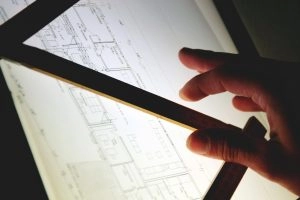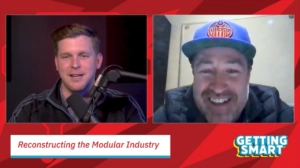How to Find Products That Matter in the Noisy Digital Landscape
This article is the first of a three-part series entitled “How to Stay Connected and Relevant in the Digital Age of Design” and is featured on MarketScale AEC.
Thomas Friedman uttered some prophetic words when he claimed “The World is Flat” in his now famous 2005 book. It’s unclear if he truly understood how technology was going to change the landscape of the world’s economy, but his primary argument centered around the ease of communication in the digital age.
The ease of commerce in the 21st century has been just as impactful. While the world is becoming flatter with each passing day (not that kind of flat, Kyrie), that doesn’t necessarily make everything easier.
 For the AEC industry, finding products in a sea of Google searches and Pinterest boards has become an art form of sorts. Has the ability to instantly market a product lowered the barrier to entry (in a great way for consumers)? Absolutely. However, more options mean more of a need to sift through the noise and find products and solutions to real problems that architects and designers face every day.
For the AEC industry, finding products in a sea of Google searches and Pinterest boards has become an art form of sorts. Has the ability to instantly market a product lowered the barrier to entry (in a great way for consumers)? Absolutely. However, more options mean more of a need to sift through the noise and find products and solutions to real problems that architects and designers face every day.
In the Olden Days…
How did members of the AEC industry find products for the last 50 years? Anyone who has spent time in an architecture and design firm since Nixon was president will tell you that the “catch all” for products and materials of all varieties was the firm’s “Library.” 
I’ve visited hundreds of libraries in my career, and most of them can be described as a dimly-lit room in the corner of an office. Historically staffed by a full-time librarian, these spaces housed shelf upon shelf of binders and bins. No two libraries are organized the same, and not a single one of them is truly up-to-date with accurate content. That’s because the libraries relied on manufacturers and their reps to constantly stock and restock the libraries as information became available.
Over time, as budgets have gotten tighter and firms are trying to get more work done with less staff, the librarians have become a casualty. Some firms participate in a “shared librarian” service (meaning they have someone staff their space 1-2 days per week). Others have done away with the role entirely, putting the responsibility on their teams to keep the materials updated and current.
If You Build It, They Will Come
This won’t come as a shock, but the internet is shaking up this corner of the AEC industry. Marketing channels in all industries have been changed by the digital age, and there are encouraging trends in the AEC space that may help architects and interior designers cut through the noise to find products that matter.
 There has long been software that allowed the AEC community to digitally design spaces (AutoCAD has been around since the early 1980’s). The last decade has seen a quantum leap forward as the technology (and access to it) has improved. Now, cloud-based programs like Revit and CET Designer allow architects and designers to build sophisticated structures and layouts in a few clicks. Product-rich data and safety information is embedded into the coding of the products themselves, which leads to safer spaces and more efficiency in an industry that is famously stretched thin.
There has long been software that allowed the AEC community to digitally design spaces (AutoCAD has been around since the early 1980’s). The last decade has seen a quantum leap forward as the technology (and access to it) has improved. Now, cloud-based programs like Revit and CET Designer allow architects and designers to build sophisticated structures and layouts in a few clicks. Product-rich data and safety information is embedded into the coding of the products themselves, which leads to safer spaces and more efficiency in an industry that is famously stretched thin.
The Library, Reborn?
What about those libraries we discussed earlier, though? While most firms still house materials in a central hub of some sort (designers need to see, touch, and feel after all), there has been a digital shift in this space. MyResource Library (MRL) was founded six years ago to take the outdated libraries of the last 50 years and bring them into the modern age.
Its site, which is free for architects and designers to access, takes the “endless aisle” approach that made Amazon a juggernaut and applies it to the Contract Furniture industry. Hundreds of manufacturers have seen the value, and the library is adding hundreds of product updates each month, making it the most accurate single library in the entire industry.
Manufacturers aren’t the only ones who appreciate this approach, either. More than 200 A&D firms and 200 furniture dealerships have partnered with the website, according to founder Jeff Carlson.
Sandow Media (the parent company of Interior Design Magazine) is behind another interesting digital solution to a traditional problem in the AEC world. Remember how we just covered that architects and designers like to see, touch, and feel materials and products? Enter, Material Connexion, a team that wants a sustainable solution to put limitless product and material samples into the hands of designers, with the click of a button. It is working with global brands like BMW, IKEA, and Hermes and act as a “materials consultancy” to make accessibility possible for thousands of interior designers.
What’s Next
All of the specification and product search problems that plague architects and designers haven’t been solved, by any means. However, there are strides being made each year that change the way the AEC industry works. Whether it’s digital building tools like Revit or CET Designer, specification tools like MRL or Designer Pages, or materials platforms like Material Connexion, the industry is changing.
We may be reaching a tipping point where technology and communication are becoming so much easier that the fundamental work that an architect or designer does will look drastically different in a few short years.
For the latest news, videos, and podcasts in the AEC Industry, be sure to subscribe to our industry publication.
Follow us on social media for the latest updates in B2B!
Twitter – @AECMKSL
Facebook – facebook.com/marketscale
LinkedIn – linkedin.com/company/marketscale








